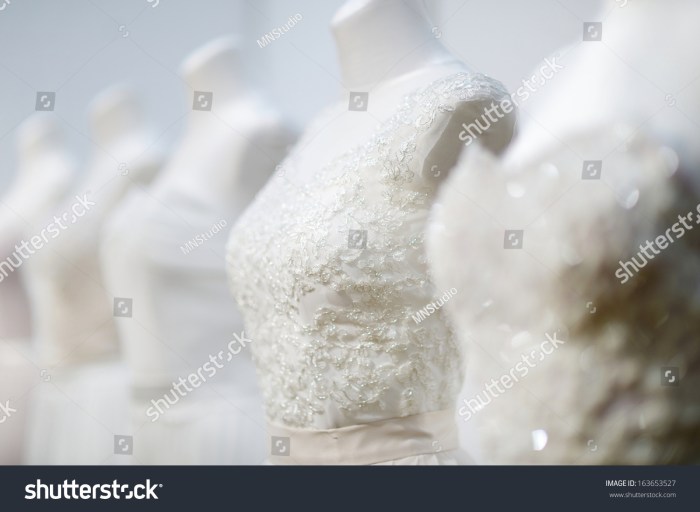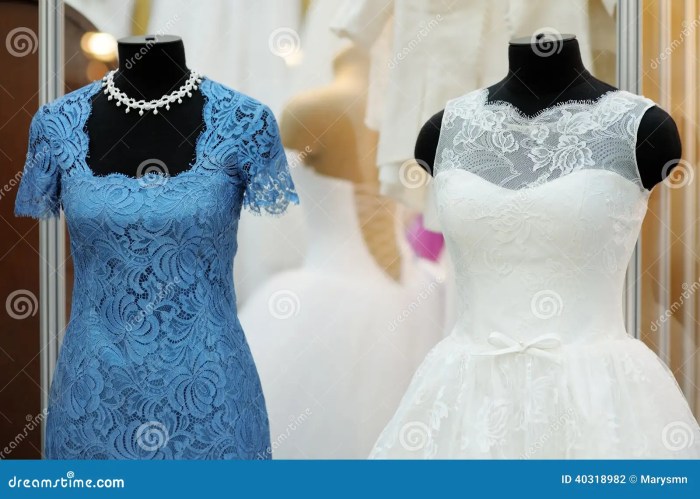Visual Appeal of Wedding Dresses on Mannequins
The visual presentation of wedding dresses on mannequins is crucial for attracting customers and conveying the essence of each gown. Effective display hinges on careful consideration of lighting, mannequin pose, and overall design. This section will explore how these elements contribute to a captivating and persuasive presentation.
Lighting’s Impact on Wedding Dress Detail
Strategic lighting dramatically enhances the visual appeal of wedding dresses. Soft, diffused lighting minimizes harsh shadows, allowing intricate details like beading, embroidery, and lace to shimmer and catch the eye. Conversely, strategically placed spotlights can highlight key features, such as a plunging neckline or a dramatic train. Warm lighting creates a romantic atmosphere, while cooler lighting offers a more modern and sophisticated feel.
Mannequin Poses and Perceived Elegance
The pose of the mannequin significantly influences how the dress is perceived. A graceful, poised pose can emphasize the flow and elegance of the gown, while a more dynamic pose can convey a sense of movement and energy. Consider the style of the dress: a classic A-line gown might look best on a mannequin standing straight and tall, while a more modern, form-fitting dress could benefit from a slightly turned pose to showcase its silhouette.
Full-Body vs. Torso Mannequins
The choice between full-body and torso mannequins depends on the style of the dress and the overall display goals. Full-body mannequins provide a complete view of the gown, including the train and how it drapes on the body. Torso mannequins are ideal for showcasing intricate details in the bodice and skirt, without the distraction of a full figure. They are also more space-efficient.
Visual Merchandising Display with Color Coordination
A well-designed visual merchandising display uses color coordination to create a cohesive and visually appealing presentation. Consider grouping dresses by color family (e.g., ivory, champagne, blush) or creating a rainbow effect for a more playful display. The background and props should complement the colors of the dresses, avoiding clashing or distracting elements.
For example, a display featuring ivory and champagne gowns could utilize a neutral backdrop with soft, romantic accents like sheer fabrics or floral arrangements in pastel shades. A bolder display featuring jewel-toned gowns might use a dark backdrop with metallic accents to enhance the richness of the colors.
Description of a Wedding Dress on a Mannequin
Imagine a stunning A-line gown in ivory silk crepe displayed on a classic, elegant mannequin. The dress features delicate lace appliqués cascading down the bodice and skirt, culminating in a chapel-length train. The mannequin’s pose subtly showcases the dress’s graceful silhouette and the intricate detailing. The overall effect is one of timeless elegance and refined sophistication.
Mannequin Selection and Dress Presentation
Selecting the appropriate mannequin and presenting the dress flawlessly are critical for showcasing the garment’s beauty and quality. The right mannequin will complement the dress style, while proper draping and securing prevent damage and enhance the overall aesthetic.
Choosing the Right Mannequin Type
Different wedding dress styles require different mannequin types. A classic, full-bodied mannequin works well for A-line and ballgown styles, allowing the full silhouette to be appreciated. For more modern, form-fitting dresses, a sleek, abstract mannequin might be a better choice. Torso mannequins are ideal for showcasing intricate detailing on bodices or unique skirt designs.
Effective Fabric Draping and Arrangement
Proper draping is key to avoiding wrinkles and showcasing the fabric’s texture and flow. Start by gently smoothing out any wrinkles in the dress before placing it on the mannequin. Use padded hangers or dress forms to support the weight of the fabric, and strategically position pins to secure the dress without leaving marks. For delicate fabrics, consider using fabric weights or clips.
Securing Wedding Dresses Without Damage
Use appropriate pins or clips designed for delicate fabrics to secure the dress to the mannequin. Avoid using sharp pins that could snag or tear the fabric. Start by securing the shoulders and bodice, then work your way down, ensuring the fabric drapes smoothly and naturally. Always test pins or clips on an inconspicuous area of the fabric first.
Adjustable vs. Fixed-Pose Mannequins, Wedding dresses on mannequins

Source: shutterstock.com
Adjustable mannequins offer greater flexibility in posing and displaying dresses, allowing for a wider range of creative displays. Fixed-pose mannequins provide a more consistent and polished look, but offer less versatility. The choice depends on the store’s needs and the frequency of display changes.
Step-by-Step Guide to Dressing a Complex Wedding Gown
Dressing a complex gown requires patience and attention to detail. A step-by-step approach ensures a smooth and wrinkle-free presentation.
- Start by preparing the gown: remove any packaging and gently smooth out any wrinkles.
- Carefully drape the gown over the mannequin, ensuring the neckline and shoulders are properly positioned.
- Secure the gown using appropriate pins or clips, starting with the shoulders and bodice.
- Adjust the skirt to ensure a smooth and natural drape. Use weights or clips as needed.
- Step back and assess the overall presentation, making any necessary adjustments.
Retail Display Strategies
Effective retail display strategies maximize the impact of wedding dress mannequins, driving sales and creating a positive shopping experience. This section explores placement, props, and overall design considerations.
Use of Props and Accessories
Props and accessories enhance the visual appeal and storytelling aspect of the display. Veils, jewelry, and handbags can add personality and detail, while strategically placed mirrors can create a sense of depth and spaciousness. The choice of props should complement the style of the dress and the overall theme of the display.
Placement Strategies within a Retail Store
Wedding dress mannequins should be placed in high-traffic areas, ensuring maximum visibility. Consider creating dedicated display areas or incorporating mannequins into existing displays. Ensure adequate spacing between mannequins to avoid overcrowding and allow customers to easily view each dress.
Window Display Designs
Window displays offer a prime opportunity to attract customers from the street. Consider creating a cohesive theme, using lighting and props to enhance the visual impact. A simple yet elegant display can be just as effective as a more elaborate one. The key is to create a visually arresting and memorable presentation.
Comparison of Mannequin Materials
Different mannequin materials offer varying advantages and disadvantages. The choice depends on budget, durability requirements, and the desired aesthetic.
| Material | Advantages | Disadvantages | Cost |
|---|---|---|---|
| Fiberglass | Durable, lightweight, easy to clean | Can be brittle, less realistic appearance | Medium |
| Plastic | Affordable, lightweight | Less durable, may show scratches easily | Low |
| Wood | Classic look, durable | Heavy, more expensive | High |
| Fabric-covered | Realistic appearance, soft texture | Less durable, requires more care | Medium-High |
Visually Appealing and Informative Signage
Clear and concise signage provides essential information, enhancing the customer experience. Signage should include the designer’s name, dress style, fabric, and price. Use visually appealing fonts and colors that complement the overall display.
Photography and Marketing: Wedding Dresses On Mannequins
High-quality photography is crucial for showcasing wedding dresses online and on social media. This section explores techniques for capturing the best images and using them effectively for marketing purposes.
Ideal Lighting and Camera Angles
Use soft, diffused lighting to avoid harsh shadows and highlight the dress’s details. Experiment with different camera angles to showcase the dress from various perspectives. A three-quarter view often works well, showcasing both the front and side of the dress.
Background and Props for Professional Look
A clean, uncluttered background allows the dress to be the focal point. Consider using a neutral backdrop or a backdrop that complements the dress’s color and style. Strategic use of props can add context and create a mood, but avoid overcrowding the image.
Effective Image Editing Techniques
Image editing can enhance the photos, but avoid over-processing. Adjust brightness, contrast, and saturation to optimize the image quality. Remove any blemishes or imperfections, but maintain the natural look of the fabric.
Social Media Strategies
Utilize high-quality images on social media platforms like Instagram and Pinterest. Use relevant hashtags to increase visibility. Run contests and giveaways to engage followers and generate interest. Collaborate with wedding bloggers and influencers to expand reach.
Image Captions Highlighting Dress Features

Source: dreamstime.com
Captions should highlight key features and benefits of each dress. For example: “This stunning A-line gown features delicate lace appliqués and a flowing chapel-length train. Perfect for a romantic, classic wedding.” “This modern sheath gown is crafted from luxurious silk crepe and features a flattering V-neckline. Ideal for a chic and sophisticated bride.”
Customer Experience and Sales
The presentation of wedding dresses on mannequins significantly influences customer perception and purchasing decisions. This section explores strategies to optimize the customer experience and drive sales.
Influence on Customer Perception and Purchase Decisions
A well-presented dress on a mannequin can create a strong first impression, influencing customer interest and desire. A poorly presented dress, on the other hand, can deter customers and diminish the perceived value of the garment. The overall presentation, including lighting, mannequin choice, and styling, all contribute to the customer’s perception.
Role of Mannequin Displays in Creating a Positive Shopping Experience
Mannequin displays create a visually appealing and organized shopping environment. They provide customers with a clear understanding of the different styles and designs available, making it easier for them to browse and find the perfect dress. A well-organized display creates a positive and inviting atmosphere.
Highlighting Specific Features and Benefits
Mannequin displays can be used to highlight specific features and benefits of wedding dresses, such as intricate detailing, unique silhouettes, or luxurious fabrics. Strategic use of lighting and props can further emphasize these features, making them more appealing to customers.
Effective Sales Techniques Related to Mannequin Displays
Sales associates can use mannequin displays as a starting point for conversations with customers. They can point out key features and benefits of the dresses, answer questions, and offer personalized recommendations. They can also use the displays to showcase different styling options and accessories.
Frequently Asked Customer Questions
Customers often have questions about the dresses displayed on mannequins. Providing concise answers to these questions can enhance the customer experience and drive sales.
- Q: Can I try on this dress? A: Yes, we have dressing rooms available.
- Q: What is the fabric of this dress? A: The dress is made of [fabric name].
- Q: What is the price of this dress? A: The price of this dress is [price].
- Q: Are alterations included? A: Alterations are available at an additional cost.
- Q: What other colors is this dress available in? A: This dress is also available in [other colors].
Expert Answers
What type of mannequin is best for a ballgown?
A full-body mannequin with a wide base is ideal for showcasing the full volume and dramatic silhouette of a ballgown.
How can I prevent the dress from slipping off the mannequin?
Use safety pins strategically placed along the seams and inside the dress to secure it without causing visible damage. Consider using dress forms with built-in mechanisms for securing garments.
How often should I change the mannequin displays?
Seasonal changes and new collections warrant updates. Aim for refreshing displays every few weeks to maintain visual interest and keep the store looking fresh.
Seeing wedding dresses on mannequins offers a great initial impression, showcasing the silhouette and overall design. However, a key detail often highlighted is the impact of accessories, such as the elegant accent a sash provides, as seen in many examples like those found on this site showcasing wedding dress with a sash. Ultimately, the mannequins help visualize how different elements, including a carefully chosen sash, contribute to the final look of the gown.
What are some cost-effective ways to enhance a mannequin display?
Use inexpensive props like fabric swags, strategically placed lighting, and simple, elegant backdrops. Consider using fresh flowers or greenery (if appropriate for the store’s aesthetic).
